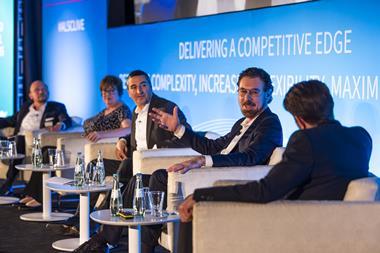 Rising prices and weak spending power, combined with a devalued currency, the low cost of oil and government cuts, add up to bleak forecasts for the Russian automotive sector
Rising prices and weak spending power, combined with a devalued currency, the low cost of oil and government cuts, add up to bleak forecasts for the Russian automotive sector
The Russian automotive logistics industry is no stranger to calamity. Veteran executives will remember Russia’s instability in 1998 during its first financial crisis several years after the end of the Soviet Union. Many from OEMs and LSPs still point to scars in their businesses from 2008-2009, when vehicle sales dropped from 3m to 1.5m units, leaving factories, warehouses and transport assets idle or sent for scrap.
Although the recovery that followed was not evenly distributed, some were surprised to see sales recover nearly back to their peak by 2012, the same year that Russia joined the World Trade Organisation. By then, carmakers and tier suppliers were again investing strongly in Russia, aiming to hit government targets set for supply and production localisation. By 2015, Russia was expected to challenge Germany as the largest market in Europe.
See also, Gefco in Russia
- An aggressive strategy for a fragile market
As it stands now, however, this could instead be the year that Russia sinks back to 2009 lows. Already, the fall in the rouble, which has lost half of its value relative to the dollar over the last year, has led most carmakers to raise their prices, hitting businesses and consumers at a time of falling wages and higher interest rates. The first of what could be a wave of OEM pullout has already begun, with General Motors recently announcing that it will withdraw the Opel brand and scale back Chevrolet sales from the market, which will include idling its St Petersburg plant indefinitely, and ending contract manufacturing in Kaliningrad and Nizhny Novgorod, along with other supply chain impacts.
With cheap oil wreaking havoc on Russia’s budget, the government is also limited in its ability to stimulate sales. While it has extended its scrappage subsidy for new car sales, that has so far not prevented an accelerated drop in the early months of the year. There are plans to reduce or possibly scrap a subsidy that has covered the logistics costs of shipping cars from Russia’s Far East back to western Russia by rail (although some municipal authorities are rumoured to be considering subsidising logistics for vehicle and component exports).
Light vehicle sales fell more than 10% in 2014 compared to 2013, from 2.77m units to 2.49m, while most forecasts this year see that falling below 2m. IHS Automotive, for example, forecasts sales of 1.81m units, a 27.4% drop, as Russia is hit by a ‘perfect storm’ of rising prices, declining spending power and eroded confidence. Some analysts are gloomier: Mikhail Plotnikov, head of marketing at Honda Motor Rus, believes the coming year will be the most difficult in the history of the Russian automotive market, estimating that sales could again go as low as 1.5m units.
Indeed, the crisis this time could be more protracted than before. With no end in sight to the conflict with Ukraine, ongoing economic sanctions, uncertainty over the price of oil, and similar economic pressures on Russia’s neighbours and key trading partners, supply chain executives face questions over whether Russia is the right place to direct inventory or production assets.
For example, a source at a Russian dealership of Toyota and Nissan believes falling profits make the brands less likely to allocate volume to Russia. “With the falling demand in 2015, we expect that the supplying strategy of [Toyota and Nissan] may be revised and the volume of supplies decreased,” he says.
Dmitry Smirnov, a Russian automotive expert, expects a sharp fall in market share among both Japanese and European brands. “Japanese brands occupy 20% of the Russian market, but the current crisis increased the cost of supplies and a large part of them probably will be redirected to other countries. By 2017-2018, they will have a share not higher than 10% of the country’s market,” he predicts. “We observe the same situation with European carmakers.”

Many companies continue to show resolve in Russia, with no plans for permanent withdrawal, aiming instead to double down on local sourcing and sustainable operations. While GM is scaling back dramatically, Ford is planning to go ahead with six launches in Russia this year. Nissan, Hyundai and Kia, meanwhile, are exploring export opportunities from their St Petersburg plants to take advantage of the cheap rouble. Reports indicate that the authorities in St Petersburg could even contribute to transport costs or custom duties.
Not all companies have been in a sales freefall. Both Hyundai-Kia and Toyota production in St Petersburg actually increased in 2014 compared to the previous year. Logistics provider Gefco, meanwhile, controlled by RZD Russian Railways, has managed to find some success in Russia despite the downturn and poor sales at its largest global customer, PSA (GM's pullout will also hurt its business, as Gefco is the carmaker's main provider there). Last year, new contracts signed in Russia were worth some $150m worth of cumulative new business for Gefco.
Prior to the GM announcement, Sergei Lepnuhov, director of public relations at GM Russia, told this magazine that the only way for manufacturers to deal with the weak currency is by increasing production and supplier sourcing within Russia. “Currently, our goal is to bring the level of localisation to 60% in enterprises throughout Russia, but it is not a matter of achieving that in one year,” he said.
However, with the sales situation worsening, GM has evidently made the decision that it cannot achieve this localisation in the long term. Although the carmaker had signed up to Russia's 'Decree 166' regulations several years ago, which exchanged preferential import duties for higher local production and sourcing.
Indeed, others have also pointed out that localisation can only be effective with production scale. With sales falling, many OEMs besides GM, including Ford, Volkswagen, Renault and PSA, have suspended or reduced output at plants.
Dmitry Smirnov points out that earlier plant investments were based in part on forecasts by the Russian Ministry of Economic Development that saw Russian vehicle sales approaching 4m units by 2015. “With sales falling below 2m units, increasing localisation and production becomes meaningless. Production costs are excessive, and it would be appropriate to consider the closure of plants and switching entirely to [vehicle] imports.”
A report by the Russian Association of Automotive Producers (OAR) predicts that, depending on the market, other foreign brands may suspend production in Russia for the rest of the year, and others may even leave the market altogether. “All in all, we expect that [production] of some vehicles in the budget segment, with low levels of localisation, may not only see cuts in investments, but may even leave the market,” says a spokesperson from OAR.
Fewer free rides
There are also threats to production at plants in Russia’s Far East, especially in the face of a cut in government support for logistics costs. To promote industrial growth in the east, the government has for years effectively paid the costs of moving finished vehicles to the main Russian markets in the west. Such has been the case at the Sollers plant in Vladivostok, for example, which builds Toyota, Mazda and Ssangyong vehicles.
It is now expected that this support, which has been crucial to production, will be reduced substantially, following cuts put into effect last year. According to automotive analyst Autostat, in 2013 the logistics subsidy was 5 billion roubles ($150m, based on the exchange at the time); last year, the subsidy dropped to 3 billion roubles ($49.5m, at today’s exchange rate); by 2017, according to the government’s draft budget, the subsidy will be 1.5 billion roubles, if it is not cut altogether.
Alexander Morozov, director of the Department of Transport and Special Engineering at Russia’s Ministry of Industrial Trade, hopes that increases in local production and sourcing will partly make up for higher transport costs.
The planned cuts come at a time of increasing interest in Trans-Siberian rail services, including movement of parts and material between China, Russia and Europe (services which are not eligible for the subsidy). Gefco, among others, has reported rising interest on the route.
Neighbourhood worries
Some good news of late for supply chain managers in Russia has been the further integration of the Eurasia Economic Union (EEC), which has removed trade barriers and tax charges for shipping vehicles from Russia to fellow members Belarus and Kazakhstan. Armenia and Kyrgyzstan are expected eventually to join.
However, companies that have been looking to use excess Russian production capacity to supply these and other CIS countries will find them facing difficult economic straits as well, including tumbling currencies and sales figures. In Kyrgyzstan, for example, recent attempts by the government to increase vehicle duties has been met with protests, while thousands of imported cars are reportedly stuck at the border.

Oleg Nazarenko, head of the Ukrainian dealer’s association, UAAID, predicts these fees could bring car imports to Ukraine to a total stop. “The bills would in fact ban official automobile import, which is already almost at zero. They would force this segment of imported goods to the ‘shadow’ market,” he says, adding that the new government is making the same mistake as the old, toppled regime, which introduced higher duties only to have to backtrack six months later.
The situation remains bleak. Many in the region are only hoping that in six months everything will change again.
Logistics experts from OEMs and logistics providers will get the chance to talk through strategies for managing through the current challenges in Russia during the annual Automotive Logistics Russia conference, which will take place in Moscow on June 24th. Click here for more details.





















